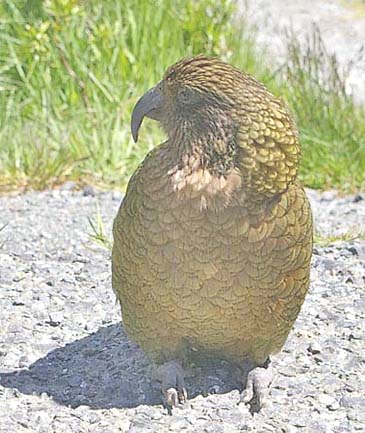
a web page by Don Roberson |
NEW ZEALAND PARROTS Strigopidae |
|
There are other parrots on New Zealand, such as Red-fronted Parakeet Cyanoramphus novaezelandiae or Yellow-fronted Parakeet C. auriceps, but these are in the family Psittacidae and their ancestors were much more recent immigrants to the islands. The three New Zealand Parrots of this family — Kea, Kaka, Kakapo — have a much more ancient origin. In a study of an intron in the spindlin genes, de Kloet & de Kloet (2005) found that this clade was the sister group of all other living parrots. Homberger (2003), working with morphological features, also considered the Strigopidae a separate family. There is still debate about how many families should be formed among the psittacines, but I follow Christidis & Boles (2008), and now all the world checklists, in considering the Strigopidae a separate family. |
The two members of the genus Nestor replace each other by altitude. Kaka live in low-lying forests, while Kea dwells in wooded valleys and moorland at higher elevation. In fact, Kea (right, another John Sullivan photo) is particularly interesting because it has adapted to life near or above snowline, high in the mountains, and undertakes altitudinal migrations between summer and winter. It has an elongated upper mandible which is used to dig for roots. It is also known to cling to sheep and rip into them, drinking their blood. It also scavenges on dead sheep. The lowland Kaka utilizes two odd food sources: sap and honeydew. They are known to strip bark from a branch or trunk to expose the cambium layer, and then lick the sap that exudes. They also may gouge tiny holes. Honeydew is taken from a scale insect in Nothofagus forests in summer and fall (Collar 1997).
|
The totally unique Kakapo is huge, flightless parrot. The 3 kg (=6.6 pound) males are the world's heaviest psittacine. As it is flightless, evolved in a hand without terrestrial predators, it succumbed rapidly to introduced non-native stouts, cats, and dogs. It is now one of the world's rarest birds, and all have been removed to remote offshore islets off the New Zealand mainland in hopes of saving it from extinction. The males call for mates by "booming" at night from traditional bowls they create high on ridge in Nothofagus forests [incredible footage appears in David Attenborough's "Life of Birds" series]. These areas are totally protected and open only to researchers; this is a bird which is currently virtually impossible to see. |
Photos: John Sullivan photographed the Kea Nestor notabilis on South Island, New Zealand, in August 2004. Photo © John Sullivan, used with permission; all rights reserved. Bibliographic note: this small family does not have a "family" book, but is covered among the Psittacidae in Collar (1997). Literature cited:
|
 The New Zealand parrots are a family of three unique parrots in New Zealand: Kea (left, a nice shot by John Sullivan), Kaka Nestor meridionalis, and the remarkable Kakapo Strigops habroptilus. [An additional species, Nestor productus on Norfolk I., off New Zealand, went extinct about 1851.]
The New Zealand parrots are a family of three unique parrots in New Zealand: Kea (left, a nice shot by John Sullivan), Kaka Nestor meridionalis, and the remarkable Kakapo Strigops habroptilus. [An additional species, Nestor productus on Norfolk I., off New Zealand, went extinct about 1851.]  The Strigopidae are unique in a number of ways. For example, all other parrots mate for life but this New Zealand group does not. The Kea is polygamous and observes a strict hierarchy with top males having up to 4 mates; the Kakapo forms no bonds at all.
The Strigopidae are unique in a number of ways. For example, all other parrots mate for life but this New Zealand group does not. The Kea is polygamous and observes a strict hierarchy with top males having up to 4 mates; the Kakapo forms no bonds at all.